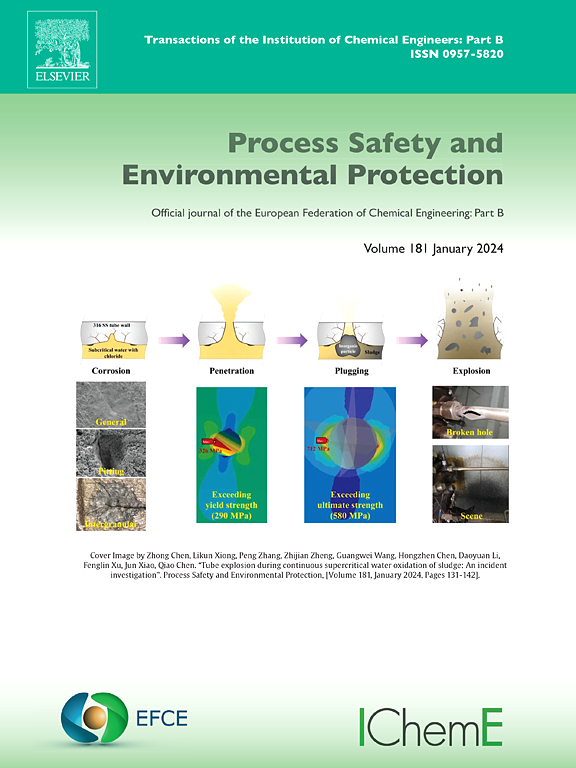Enhancing Acacia dealbata valorization through microwave-assisted autohydrolysis: An energy-efficient approach to oligosaccharides and bioethanol production
IF 7.8
2区 环境科学与生态学
Q1 ENGINEERING, CHEMICAL
引用次数: 0
Abstract
Microwave-assisted autohydrolysis (MAA) has gained attention as an alternative to conventional hydrothermal treatment (CHT) to solubilize hemicellulosic-derived compounds, such as oligosaccharides, within shorter residence times. MAA assays were conducted on Acacia dealbata wood, an invasive species, at severities (S0) ranging from 3.63 to 4.64 to optimize xylooligosaccharides (XO) recovery and assess the enzymatic susceptibility of the spent solids for bioethanol production. S0 between 3.77 and 4.15 yielded XO concentrations > 9.8 g/L corresponding to a recovery of > 80 % regarding initial xylan. Besides, at S0= 3.77, a bioethanol yield of 71 % was attained (26.25 g/L). Furthermore, CHT was performed at S0 values of 3.80 and 4.44 to compare the impact of both heating strategies under optimal conditions for (i) XO production and (ii) higher enzymatic susceptibility of the spent solid. MAA resulted in higher bioethanol yields and, particularly under harsher conditions, lower by-products formation and higher oligosaccharides content. Additionally, MAA consumed 2.60–2.75-fold less energy than CHT.
通过微波辅助自水解提高阿拉伯胶的增值:低聚糖和生物乙醇生产的节能方法
微波辅助自水解(MAA)作为传统水热处理(CHT)的替代方法,在更短的停留时间内溶解半纤维素衍生的化合物,如低聚糖,已经引起了人们的关注。以外来入侵物种金合欢(Acacia dealbata)为研究对象,在浓度(so0)为3.63 ~ 4.64的条件下,进行MAA测定,以优化低聚木糖(xylooligosaccharides, XO)的回收率,并评估其对生物乙醇生产的酶敏感性。在3.77 ~ 4.15范围内得到XO浓度>;9.8g/L,对应于初始木聚糖的回收率>;80%。在so0 =3.77时,生物乙醇的产率为71% (26.25g/L)。此外,在S0值为3.80和4.44时进行了CHT实验,以比较两种加热策略在最佳条件下(i)产生XO和(ii)提高废固体的酶敏感性的影响。MAA导致更高的生物乙醇产量,特别是在更恶劣的条件下,更低的副产物形成和更高的低聚糖含量。此外,MAA消耗的能量比CHT少2.60 - 2.75倍。
本文章由计算机程序翻译,如有差异,请以英文原文为准。
求助全文
约1分钟内获得全文
求助全文
来源期刊

Process Safety and Environmental Protection
环境科学-工程:化工
CiteScore
11.40
自引率
15.40%
发文量
929
审稿时长
8.0 months
期刊介绍:
The Process Safety and Environmental Protection (PSEP) journal is a leading international publication that focuses on the publication of high-quality, original research papers in the field of engineering, specifically those related to the safety of industrial processes and environmental protection. The journal encourages submissions that present new developments in safety and environmental aspects, particularly those that show how research findings can be applied in process engineering design and practice.
PSEP is particularly interested in research that brings fresh perspectives to established engineering principles, identifies unsolved problems, or suggests directions for future research. The journal also values contributions that push the boundaries of traditional engineering and welcomes multidisciplinary papers.
PSEP's articles are abstracted and indexed by a range of databases and services, which helps to ensure that the journal's research is accessible and recognized in the academic and professional communities. These databases include ANTE, Chemical Abstracts, Chemical Hazards in Industry, Current Contents, Elsevier Engineering Information database, Pascal Francis, Web of Science, Scopus, Engineering Information Database EnCompass LIT (Elsevier), and INSPEC. This wide coverage facilitates the dissemination of the journal's content to a global audience interested in process safety and environmental engineering.
 求助内容:
求助内容: 应助结果提醒方式:
应助结果提醒方式:


